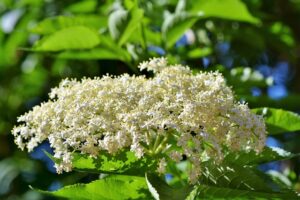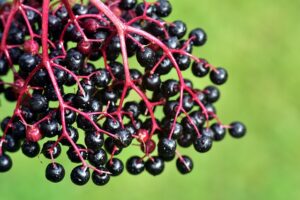Elderberry shrubs, known for their medicinal and culinary uses, are an excellent addition to any home garden. To learn how to grow Elderberry trees, follow the steps below. Remember, while elderberries are beneficial, their leaves, stems, or raw berries can be toxic if consumed. Always cook elderberries before consuming them.

Varieties of Elderberry Bushes
Elderberry trees come in a multitude of varieties, each possessing distinctive attributes. The ‘Black Lace’ variety is admired for its striking dark purple-black foliage, while the ‘Lemony Lace’ produces vibrant yellow and chartreuse foliage. ‘Sambucus nigra’, or the European elderberry, is beloved for its large clusters of white flowers and large, juicy fruit. Meanwhile, ‘Sambucus canadensis’, the American elderberry, is a popular choice for its adaptability to a variety of soil conditions and its abundant fruit production. Each of these varieties has its own pros and cons, and the choice will largely depend on your garden conditions and personal preferences. Always remember to thoroughly research the specific needs of your chosen variety to ensure a flourishing growth and bountiful harvest.
Choosing the Right Location
Choosing the right location for planting your elderberry tree is crucial for its thriving growth. Elderberries prefer sunny locations, though they can tolerate partial shade. However, more sunlight often results in more abundant fruit production. Consider a place where the tree will receive at least six hours of sunlight a day. Additionally, ensure the site has well-draining soil as elderberries don’t fare well in waterlogged conditions. While they can adapt to a variety of soil types, elderberries prefer slightly acidic to neutral soil (pH 5.5-7.0). If you’re planting more than one tree, remember to leave adequate space between them for air circulation and growth, typically 6-10 feet apart as elderberry bushes grow 6-10 foot tall and wide. Considering these aspects when deciding on a location can significantly contribute to the success of your elderberry farming.

Planting Elderberries
When it comes to planting elderberries, the optimal time is in early spring, after the risk of frost has passed. Start by prepping the soil in your chosen location, first by removing any weeds or grass that could compete with your sapling for nutrients. Then, dig a hole that is twice as wide as the root ball of your plant and just as deep. Place the sapling in the hole, ensuring that it is level with the surrounding ground. You can incorporate some organic matter or compost into the soil if it is particularly poor or heavy clay, though elderberries are generally accommodating to a variety of soils. Fill the hole back with soil, tamping it down gently to avoid any air pockets. Make sure to water thoroughly after planting to help the soil settle around the roots. To further aid in establishing your elderberry, adding a layer of mulch around the base of the plant can help conserve moisture and suppress weeds. Regular watering is crucial for the first year until the plant is well established, though elderberries are relatively drought-tolerant once mature. By following these planting guidelines, you can expect a successful establishment and future growth of your elderberry tree.
Planting Elderberries in the Fall
While most prefer to plant their elderberries in early spring, fall planting is also a viable option and can actually offer certain advantages. The cooler weather and shorter days can help the sapling establish its root system before winter. This gives the plant a head-start and allows it to utilize the full growing season come next spring. Just like spring planting, it’s essential to prepare the soil by removing any competing vegetation and adding organic matter if necessary. The key difference with fall planting is ensuring the sapling is well-watered and mulched before the onset of winter, to protect it from freezing temperatures. The timing is crucial – plant too early, and the sapling may put out new growth that gets damaged by frost; plant too late, and the plant may not have enough time to establish its roots before winter. Aim for planting about 6 weeks before your area’s first predicted frost date for optimal results. As always, aftercare is crucial. Even in winter, ensure the sapling does not dry out completely. With these considerations in mind, fall can be a great time for planting elderberries.
Pruning Elderberry Bushes
Pruning elderberry is a vital part of its care regimen to ensure optimal growth and fruit production. Typically, pruning should be done in early spring before new growth begins. Start by removing any dead, diseased, or damaged branches. Then, cut back the oldest stems to ground level. Do this sparingly as elderberries produce their best fruits on second year wood. It’s also smart to thin out any crowded branches to improve air circulation and sunlight exposure, which aids in preventing disease and encourages better fruit yield. However, be cautious not to over-prune as this could stress the plant and reduce the following year’s fruit production. Remember, the goal of pruning is to maintain a healthy balance between growth and fruit production.
Are Elderberry Flowers Edible?
Elderberry flowers are indeed edible and highly versatile. They are often used to make elderflower cordial, syrups, or infused into tea for their delightful aroma and subtle sweet taste. Elderflowers are also commonly incorporated into desserts, salads, or fritters. However, it is crucial to remember that all parts of the elderberry plant, including the flowers, must be cooked before consumption to eliminate potentially harmful toxins. Always ensure to properly identify the plant before harvesting, as some elderberry species are not safe to eat.
Are Elderberries Edible?
Yes, elderberries are edible and are often used in a variety of culinary applications. They are popularly used to make jams, jellies, pies and elderberry wine due to their tart flavor. They can also be used in sauces or syrups for pancakes and waffles, or incorporated in baked goods. Elderberries are also known for their medicinal properties and are commonly used in home remedies for colds and flu. Note, however, that elderberries must be cooked before they are consumed. Raw elderberries, as well as the leaves, stems, and seeds contain a type of cyanide that can cause nausea, vomiting, and in severe cases, more serious health complications. Always ensure to properly identify and prepare elderberries before consumption.
How to Harvest Elderberry
Harvesting elderberries requires careful attention and proper timing. The berries ripen typically around August to September, but this can vary based on your geographical location. When ripe, the berries will turn a deep purple or black color. To harvest, clip the entire cluster of berries from the tree, taking care not to crush the berries in the process.
Once harvested, separate the ripe elderberries from the cluster by gently combing through the clusters with a fork or your fingers. Discard any green or unripe berries along with the stems. Remember, elderberry stems and unripe berries contain toxins and should not be consumed.
Finally, rinse the berries thoroughly under cool water to remove any residual dirt or insects. Spread the berries out to dry on a clean towel, or proceed to cook them immediately if desired. Always remember to cook elderberries before consumption to neutralize any remaining toxins.
Winter Care for Elderberry Bushes
During the winter season, it is crucial to provide special care for your elderberry bushes to ensure their healthy return in spring. To begin, wrap the base of the bushes with a layer of burlap, safeguarding the roots from freezing temperatures. Additionally, covering the soil with a thick layer of mulch will provide extra insulation against the cold. In late winter or early spring, prune the bushes by removing any dead wood or excessively long branches. This will encourage new growth and maintain a manageable size for the bush. It is also important to remain vigilant for any signs of disease or pest infestation and promptly address them. Remember, a well-tended elderberry bush will generously reward you with an abundant harvest in the upcoming season.
Conclusion
Elderberries are versatile and nutritious berries that reward the meticulous gardener with a generous harvest. With their slightly tart flavor, elderberries can be used in many recipes or enjoyed fresh off the bush. Though they require some special care throughout the year, with patience and dedication your elderberry bushes will thrive for years to come! To ensure maximum productivity, avoid planting too closely together and keep the area weed-free. Regular pruning is also necessary for optimal growth. With proper care, you can enjoy a bountiful elderberry harvest year after year!
For information on how to grow blueberries click here.
